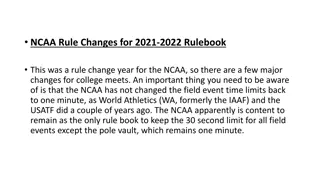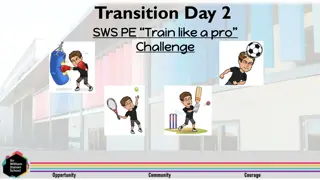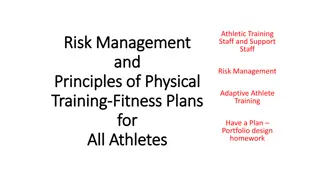
Psychophysiology of Program Design: Integrated Athlete Development
Humans are complex systems, and coaching for optimal athlete development requires understanding the interplay of physiological, mechanical, social, and psychological components. This session challenges traditional approaches by emphasizing the integration of various systems for a holistic coaching experience. Explore how fatigue, both peripheral and central, impacts performance and learn about the Catastrophe Model underlying exercise termination due to metabolic changes causing peripheral fatigue.
Download Presentation

Please find below an Image/Link to download the presentation.
The content on the website is provided AS IS for your information and personal use only. It may not be sold, licensed, or shared on other websites without obtaining consent from the author. If you encounter any issues during the download, it is possible that the publisher has removed the file from their server.
You are allowed to download the files provided on this website for personal or commercial use, subject to the condition that they are used lawfully. All files are the property of their respective owners.
The content on the website is provided AS IS for your information and personal use only. It may not be sold, licensed, or shared on other websites without obtaining consent from the author.
E N D
Presentation Transcript
Psychophysiology of Program Design
Humans are complex systems. When coaching we tend to look at the pieces but optimal development of an athlete can only occur when we realize that every system in the body affects every other system. This session will encourage you to look outside the box, treating the athlete as a integrated system of physiological, mechanical, social, and psychological components. 3/17/2025
Systems Approach Exercise and coaching science has traditionally been taught using discrete systems and blocks of learning Physiology Biomechanics Motor learning Technique Nutrition Psychology Ethics etc 3/17/2025
Systems Approach Integration of the systems is often ignored and in some cases discouraged Coaches develop areas of expertise based on available information sources, personal preferences and personal experience 3/17/2025
Definitions of Fatigue Fatigue - An inability to maintain a power output or force during repeated muscle contractions (Powers and Howley, 2001) Peripheral - Decreased capacity of skeletal muscle to generate force because of action potential failure, E-C coupling failure, impairment of cross bridge cycling, in the presence of increased or unchanged neural drive (Hakkinen and Komi, 1983) Central - Reduction in neural drive to the muscle resulting in a decline in force production or tension development that s independent of changes in skeletal muscle contractility (Enoka, 1992)
Peripheral Fatigue The Catastrophe Model Exercise terminates because of a catastrophic failure of homeostasis Increasing neural drive maximises motor unit (MU) recruitment allowing exercise to continue Metabolic changes lead to system failure of either the peripheral muscles or the heart (Edwards, 1983)
The Catastrophe Model Proposed metabolic changes causing peripheral fatigue include (Fitts, 1994): Increased lactic acid concentration PH decreases AND associated proton accumulation ATP and PCr depletion Accumulation of ADP, IMP, and inorganic phosphate Changes in skeletal muscle Na+/K+ ATPase pump Sarcolemmal t-tubule and sarcoplasmic reticulum Ca2+ mediated functional changes
Central Fatigue Is fatigue really about the muscles and energy systems or is it really just a matter of perception?
Just Do It Performance is a battle of Do it signals against Don t do it signals Positive expectations weighed against the cost of doing something Focus and attention (Mark Fenske - Globe and Mail June 23, 2011)
Centrally-acting performance modifiers Music Placebos Self-belief Prior experience Time deception Knowledge of the endpoint Presence of competitors Naloxone Acetaminophen Amphetamines Modafinil Monetary reward Glucose ingestion Cerebral oxygenation Mental fatigue/ Sleep loss Bupropion Anticipation (Teleoanticipation) End Spurt World records Laboratory experiments Begin exercise at different intensities Afferent sensory feedback Rate of increase in RPE predicts the exercise duration, also during VO2max testing Heat or Dehydration FEEDBACK FEED FORWARD Hypoxia or Hyperoxia Reserve Submaximal recruitment at exhaustion Glycogen stores Lactate paradox of altitude Muscle soreness, fatigue or damage Running downhill VO2max occurs at submaximal muscle recruitment
Perception Vs Reality Practice and experience can alter the perception of the difficulty of a task Awareness of different sensations
The Rating of Perceived Exertion (RPE) Scale 6 No exertion at all 7 8 Extremely light 9 Very light 10 11 Light 12 13 Somewhat hard 14 15 Hard (heavy) 16 Developed by Gunnar Borg. The RPE is a measure of how physiological changes due to intensity affect psychological perceptions 17 Very hard 18 19 Extremely hard 20 Maximal exertion
RPE measures the duration of exercise that remains 20 Low glycogen High glycogen Fatigue occurs at same RPE 20 Low glycogen 19 19 High glycogen Fatigue occurs at submaximal RPE 18 18 The linear rise in RPE indicates that the RPE is set from the start and must serve some purpose. 17 17 16 16 Ratings of Perceived Exertion Ratings of Perceived Exertion 15 15 14 14 13 13 12 12 11 11 10 10 0 20 40 60 80 100 120 140 160 0 20 40 60 80 100 Time (min) % Time J Baldwin et al. JAP 2003; 94: 2181-7; TD Noakes. JAP 2004; 96: 1571-2. J Baldwin et al. JAP 2003; 94: 2181-7; TD Noakes. JAP 2004; 96: 1571-2.
RPE and Exercise Duration 20 18 16 14 12 10 7 mile race 21km race 8 RPE 6 25 50 Time (min) 75 100 125 20 18 16 14 12 10 8 RPE 6 0 Faulkner J, Parfitt G, Eston RG. Psychophysiology 45:1-8, 2008 20 40 60 80 100 Time (%)
Managing Brain and Body How can you create the optimal environment for performance?
Something to consider Rowers often train at the worst time of the day Early morning Cortisol levels highest Hydration levels low Carb depleted Nervous system arousal low Long training blocks not as effective
Dedicated vs Distributed Dedicated training Single focus for each training session Traditional in rowing Easiest to plan Creates considerable fatigue May limit total weekly exposures to certain training levels
Dedicated vs Distributed Distributed Small amounts of high intensity training done every day Makes planning a workout more difficult Less fatigue accumulation Allows higher volume of intensity work per week
Context and Specificity Many coaches like to use stadium runs or other high intensity cross training activities to work on toughness Dosing athletes with high intensity work can help create mental toughness but only if the context is correct External visual and auditory cues Body position Movement patterns Breathing pattern entrainment to rowing stroke






















